
HOME
| View this page at 1024x768
Contact Webmaster
This page last updated February 2008.
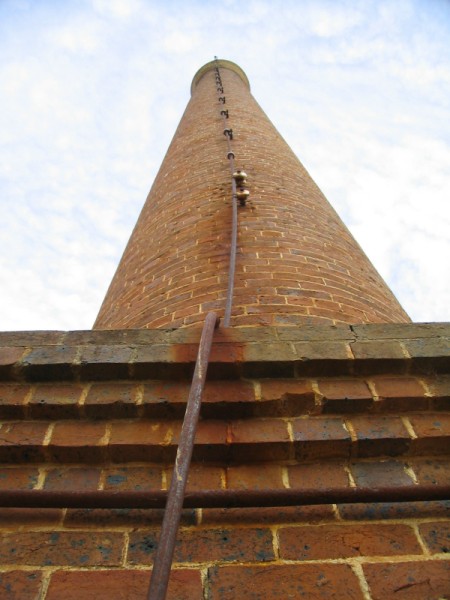
Over 100 years old, the chimney has weathered the years well. Note the bricks have been made curved.

Part of the old mine workings - note the angle of the reef. Mt. Bodangora is visible in the distance on the left of pic. The old school & residence is also visible.
|
Mitchell's Creek - Bodangora
Quartz reef gold mine
Pre 1889
The earliest mining records for Mitchell's Ck. date from 1875, almost 35 years after McGregor had first discovered his secret reef.
Frederick Marsh, Mining Registrar wrote in 1875
'The Mitchell's Creek Mining Co. - about 20 men employed; length of line worked, about 3/4 of a mile; depth reached, 130 ft; reef about 20 inches wide; average yield throughout, about 9dwts; strike of reef , north & south, 2 points west, dip to the east'.
'The mode of treating material at Mitchell's Creek, is by quartz fifteen head battery, copper plates, blankets, and buddles; quartz operated on averaging 9dwts; no new mode of treatment in use; about 9,000 tons of tailings stacked.
Also in 1875 - 'At Mitchell's Ck. two highly encouraging lodes have been partially worked. To one of these, known as 'Fitler's Mine', machinery to the value of £2,000 is being conveyed at the present time.
1876 - Quantity got at 170ft, 7216 tons crushed; average yield 10dwts 7.11gms. per ton; width of reef 2ft6inch; dip of reef E45deg; strike 20deg W of N.
1877 - Quantity got at 245ft. Width of reef 2ft. Dip of reef W. Strike N.
|
1877 report
'The most profitable & apparently most permanent quartz reef in the district is situated on Mitchell's Creek, in the vicinity of Wellington. This well-defined reef, known as the Mitchell's Creek Mine, has been worked now for many years past, formerly by the Mitchell's Creek Company, but now by two gentlemen of capital residing in Sydney. It has largely contributed to swell the amount of gold sent away by the escort from Wellington, which this year reached the total of 3,127ozs. This mine is worked by tributors, who pay to the proprietors 15% of the gold won as a royalty, and also at the rate of 10s per ton for all stone crushed. The water used for the plant is pumped by steam from the creek, a distance of nearly 2 miles. The pyrites have been hitherto stacked for after treatment, but it is in contemplation by the proprietors to erect a roasting furnace and a Chilian mill for their complete and profitable reduction. The samples, as exhibited, appeared to be exceptionally rich'.

A view from the old mine workings at Mitchell's Ck. with the Wellington Valley visible in the distance center of pic. The old boiler is a Cornish boiler & possibly the one as described below which ran the crushing plant. The area immediately behind the boiler was for many years a large area of sand from the crushings known locally as the 'Sand Hills'. These sand hills were reprocessed several times from around 1970???? check - the whole area being covered with topsoil after the final treatment due to the poisonous nature of the process.
1878 report
'The Mitchell's Creek Reef, under Captain Richards, has just been engaged in raising several hundred tons of stone to grass from a deeper level than has yet been touched. The tributes will commence crushing at the machine belonging to the reef. This is one of the best paying & best managed reefs in NSW & apparently is as permanent as profitable. Produced 1,422ozs. at an average 16dwts.
1879 - Mitchell's Creek Mine 879 tons for 1041ozs. Workings 130ft deep.
1880 - Mitchell's Creek Co. - Quartz obtained at 360ft. Reef 2ft wide. Dip E, Strike N. 1415 tons yielded 849ozs.
1881 report
'The Mitchell's Creek mine, I am given to understand, did not work at all during any part of the year, a person having been left simply in charge of the premises as caretaker, and who could not give me any information. But I believe this mine, plant &c. has been recently sold to an English company, which is not only a very good criterion of the value of the mine, but a guarantee that it will be worked effectively in the future.
And so the Mitchell's Creek mine was idle from 1881 until 1890 when another much larger attempt was made to make it a profitable venture.
|
|
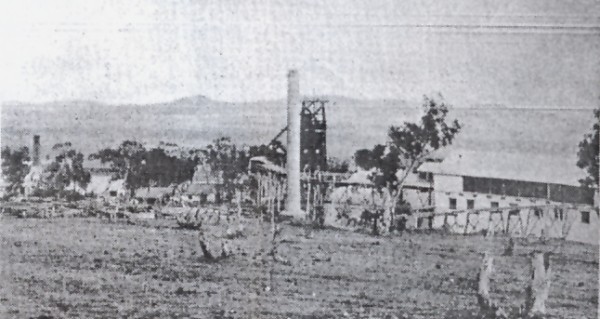
Mine buildings 1904 (Town & Country Journal)
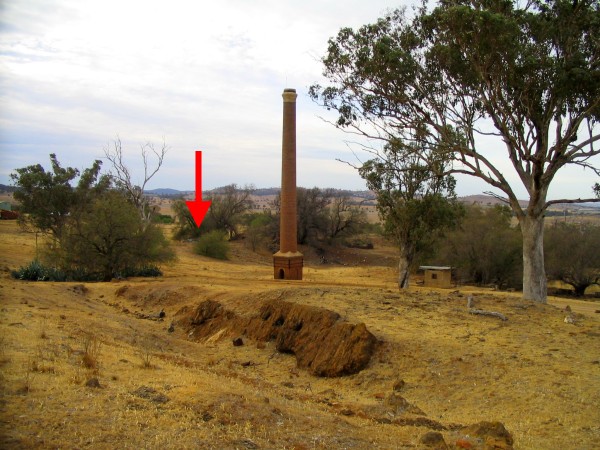
Image from 2006. Arrow shows position of No. 2 shaft.
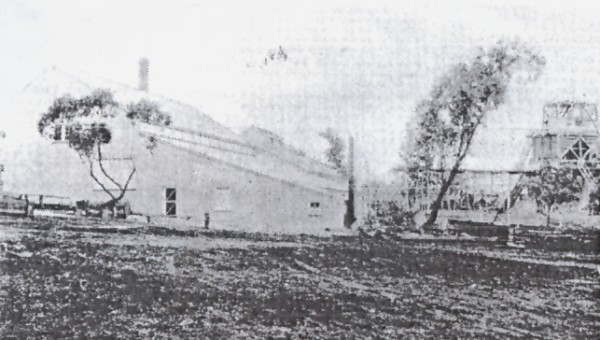
The shaft as shown by the arrow in the 2006 pic is on the right of this 1904 pic (Town & Country Journal). The building housing the winding-pumping gear is shown more clearly in the pic below.
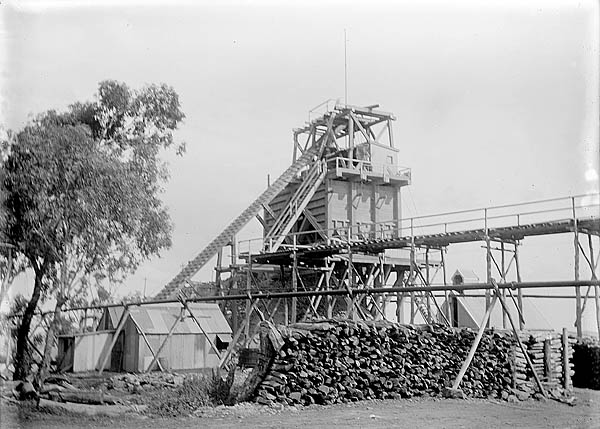
No. 2 mine - date unknown.
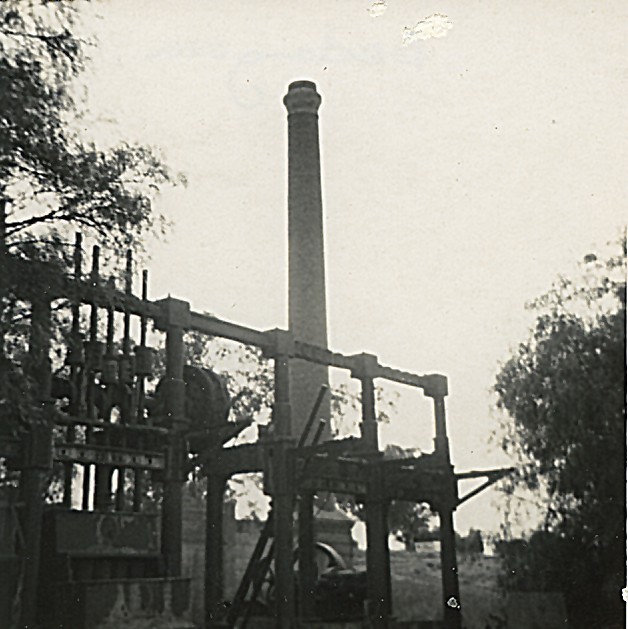
Crushers and chimney taken abt 1970.

Marshall's portable steam engine. View Anthony Legg's interesting gallery
HERE

Blake Steam Pump. View gallery
HERE
|
1889 - 1918
Description of the Mitchell's Creek Freehold Gold Estate, Wellington NSW.
Jas. M. Lindlay 10/3/1891
'This well-known ground which has been the property successively of a public company, of two absentee owners, and now of a private co-partnery of four (one being resident), occupies the spot from which gold-bearing stone was said to have been obtained, as early as 1848, by a shepherd from Montefiores named MacGregor (vide Professor Liversidges "Minerals of New South Wales" page 33), and has been worked as far back as twenty years ago.
The ground comprises an area of 600 acres freehold land, situated close by the Wellington to Gulgong road, about eight miles from Wellington township, in the parish of Bodangora, and overlying the divisional line between the counties of Bligh and Lincoln. It is traversed by a strong quartz reef, between walls of hard black diorite, exceedingly well defined, and with every indication of a permanent character.
The supply of quartz, which appears inexhaustible, is highly auriferous, and is associated with minerals of considerable value - viz; iron and copper pyrite, galena, zincblende, magnesia, alumina, a little carbonate of lime, a little cobalt, and talc; an almost constant average of 18dwt. gold, 6oz. silver, and about 5lb copper being contained per ton of this lode-matter.
The reef, which is traceable a length of 8,000 feet - viz, for the whole extent of the estate - underlies to the east at an angle of 45°, its strike being N. 15° west, and has an almost invariable width of 2 feet. Owned originally by a Sydney company, the old "Mitchell's Creek Gold Mining Company", and subsequently by Messr's J.B. Rundle and S.D. Gordon, it was worked at intervals between 1869 and 1881. During these twelve years 2 portions from a central point upon this line were extensively worked - viz, southwards about 1600 feet in length, and to various depths, from 100 to 360 feet; and northwards, uphill, for about 1800 feet in length, and to depths varying from 90 to 140 feet; the extremities both northern and southern, remaining unworked. These operations took place chiefly under a tribute system, the reef being let, in respect of the free gold (but the pyrites being entirely reserved by the proprietors) in sections of 150 feet per working party, upon a royalty of 15 percent of the gold obtained. This arrangement appears to have served well in the upper portions of the reef - naturally the most abundant in free gold - but to have led to prompt cessation of work on the part of the tributors at such points that sulphides began to predominate in the vein-stuff. These workings, completely stoped-out (underhand) from the surface thus exhibit an extremely uneven line of depth. Upon reaching the water-level operations were discontinued. For the following eight years (1881-1889) no effort was made to resume working the reef, regarded by the owners as consisting thenceforward almost exclusively of sulphides too intricate to treat with profit. In 1889 the estate was purchased by the present proprietary (Messr's Philip Davies, T.M. Dalveen & J.M. Lindlay, of Sydney, and James Dick, of Glasgow) for the purpose of reopening the mine'.
The plant and machinery may be described as follows:
Winding and pumping plant, No. 1 shaft, comprises vertical Tangye boiler of 10 horse power, steaming horizontal Tangye engine, with winding gear attached; also pumping gear, working two 18-inch by 5 pumps, with two connecting-rods (of steam gas pipe) and 3 inch delivery pipe. The rods rest on friction pulleys, the shaft going down on the underlay of lode at an angle of 45deg. The pump draws the water from depth of 437ft in one column. A substantial steel tramway is laid from top to bottom of the shaft upon which the trucks are hauled by means of steel-wire rope attached to drum of the winding gear. This plant is entirely under a substantially-built wooden shed, covered with galvanised iron.
Winding and pumping plant, No. 2 shaft, is a sister plant to the above described.
Crushing plant, erected on the machinery site of the former company, about midway along the reef, consists of a new 27 feet x 6 feet Cornish boiler, with Galloway tubes seated in solid brickwork, and the flues connected with a substantial brick stack; an 18 inch horizontal engine, driving 15 head stamper battery (weight per stamper, 784lb; length of drop, 8 inches; speed 75 drops per minute); inclined wooden tables, 10 feet long, 4 feet 8 inches wide, 1 3/4 inch per foot pitch, with two mercury wells on table - one in middle, one at lower end - the intervening space covered by electro-silvered copper-plates (2oz electro-silver per super foot) in length 8 feet 2 inches, in width 4feet 8 inches, in front of each box, the remaining space - 1 foot 8 inches on each table - being occupied by wooden 'distributing-lozenges'.
Grinding and concentrating plant, about 400 feet distant from battery, and connected with same by narrow wooden shoot, conveying the pulp from stampers. This comprises one 20-horse power double-cylinder Marshall's portable engine, driving two Lamerton grinding mills imported from Glasgow. These regrind the tailings after the stampers, and discharge on to inclined tables, 8 feet by 5 feet, with pitch of 1 3/4 inch per foot, covered by electro-silvered copper-plates in following order:- Top of table, 3 foot plate; space of 2 feet unoccupied; bottom plate 3 feet. Distibuting shoots (wooden launders) and pipes deliver pulp from grinding mill tables to 6 Frue-Vanner concentrating machines, driven by a Tangye vertical 5-horse power engine, steamed from the Marshall's portable boiler. Two 7 inch plunger sand pumps, driven from the 20-horse power portable engine, return waste water from the tailings dam to the reservoir at battery through 4-inch cast iron pipes, distance 550 feet.
Both battery and concentrating plant is supplied by a line of 3-inch pipes laid down between supply-reservoir and the concentrating shed. The concentrating shed is is very substantially built, and measures 100 feet long by 60 feet wide, and 20 feet high to the wall plates. Nearly the whole floor is boarded or bricked, and a large area is kept in perfect order for depositing and bagging pyrites. The whole of the shed is covered with galvanised iron. A drying furnace of brick work for freeing pyrites from moisture opens from the shed.
The main water supply is furnished by pumping plant at the Mitchell's Creek on extreme northern end of property. A Blake steam-pump, steamed from a steel tubular boiler, 8-horse power Tangye vertical, pumps from an undercurrent on the west bank of the creek, and force the water through a mile and quarter in length of 4-inch cast-iron pipes to the supply dam at the battery.
The buildings comprise a three-roomed office (one compartment for smelting gold, one for assay weighing, and the third for clerical purposes, a very complete assay plant being housed here); a substantial residence for general manager; storehouse; smith's shop; explosives magazine (brickwork); and stable. Water is laid on to the office and residence, and every precaution provided against fire'.
|
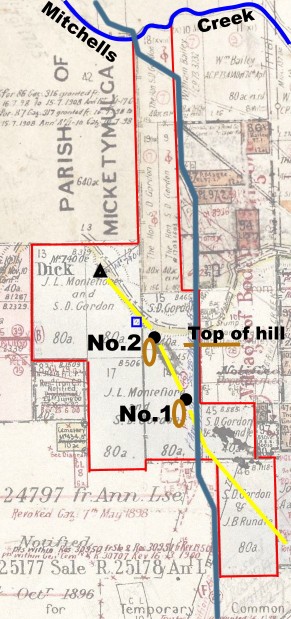
|
Report by Mr. W.H.J. Slee, Chief Inspector of Mines - Nov 1895
By November 1895 the mines had been working under the new owners for over 6 years, operations having begun in June 1889.
'In February of the present year the battery was increased to 25 head of stampers, and has since crushed 7,223 tons of quartz for a yield of 5,306oz of gold. The total number of tons of quartz crushed and yield of gold obtained up to the 19th October last, that is in five years and four months, is 28,900 tons yielding 22,531oz. dwt. 8gr of gold, giving an average of 15dwt. 14gr. per ton. The value being £83,716 10s 2p. The total number of persons employed in the mine, 98; and on the surface, including battery and chlorination works, 47, making a total of 145 persons directly employed'.
No.1 shaft had been sunk to a depth of 680 feet, but the chief supplier of quartz was No. 2 shaft which was down to a depth of 480 feet and outputting an average of 100 trucks per day, or 400 tons per fortnight. Quartz was being mined at a faster rate than the 25 head stamper could crush, and it was proposed to add another stamper of the same size. Another shaft mentioned was 'Snow's Shaft':
'Snow's Shaft, above mentioned, is a temporary working shaft, depth 76 feet; at a trial crushing of 10 1/2 tons yielded 1oz of gold per ton, and at a lower level, 200 feet from surface, assays gave recently 3oz of gold per ton. These levels are now being extended with all speed to cut under this rich stone, and the 327-foot level has already intersected it, and is extending into the rich vein at the rate of 3 feet per day. The opening up of this part will add greatly to the gold-producing power of the mine; as hitherto this part of the mine has received very little attention'.
And in conclusion:
'Through the working of this mine a town has sprung up, which has been named Daviesville, after Mr. Phillip Davies, one of the owners of the mine. The town contains a population of about 400, has a daily mail from Wellington, post office, school, and a number of business premises, including boarding-houses, but no hotel; the erection of an hotel is discouraged by the company'.
|

A view from near Snow's Shaft with the mullock heap from No. 1 shaft in the centre of the pic. Visible in the distance is the chimney adjacent to No. 2 shaft and the crushers and treatment plant. All quartz mined from No. 1 and shafts such as Snow's, was conveyed by tramline to the main battery.
|
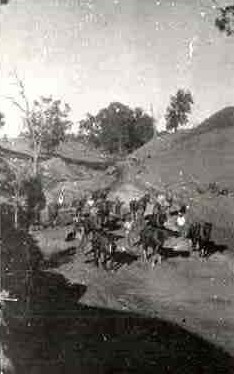
|
Wellington Gazette
Oct 6, 1898
Bodangora
'On Saturday morning one of Mr. T.McGee's horses took a 'tailer' down some of the old underlay workings, a distance of 40ft, and, wonderful to relate, was landed back on the surface in an almost undamaged condition. Hawling him back again wasn't as easy as falling off a log, but, under the directions of Mr. Thompson, the Co.'s engineer, it was accomplished by means of a pulley-block and ropes, to the end of which some of Mr Haynes' stalwart supporters were hitched. The engineer deserves credit, but his task was made comparatively easy by Nature. First a tree for hauling purpose stood in a convenient spot - an onlooker pertinently observed that 'it must have growed there'. Again, the horse had been built with a white face, which was the only part of the neddy visible in the chasm, and acted as a signal on which to centre operations.'
Picture opposite (courtesy Barbara Preston) shows horses working at the Bodangora Mine.
|
|
'-- the Principal Gold Mine in the State'
1901
The crushing plant at the Mitchell's Creek Freehold Gold Estate Mine, at Bodangora was at work until the 7th of June last only; during this period 6,246 tons of stone were treated for a yield of 3,852oz, valued at £12,657. Since that date the battery has been shut down for reconstruction, and a large and improved plant valued at £10,000, is in course of erection. During the suspensions of crushing operations, developmental work underground was actively carried on.
Also from the 1901 mining records
At Bodangora, however, the principal gold mine in the State, vis, the Mitchell's Creek Gold Mine, has been busily engaged erecting a new 40-head stamp mill, with all the latest and most approved accessories. The main shaft has also been cut down, making it of a size large enough to permit of an increased output of stone, to handle which a new winding engine has also been erected. Below surface the latest developments are highly satisfactory, and this, taken with the opening from surface of another vein in close proximity, gives promise of a successful future to this already extensive mine. The main shaft is already below the 1,000ft level, at which the stone shows no diminution in size or gold contents, while in length the shoot has been worked for a distance of fully three-quarters of a mile.

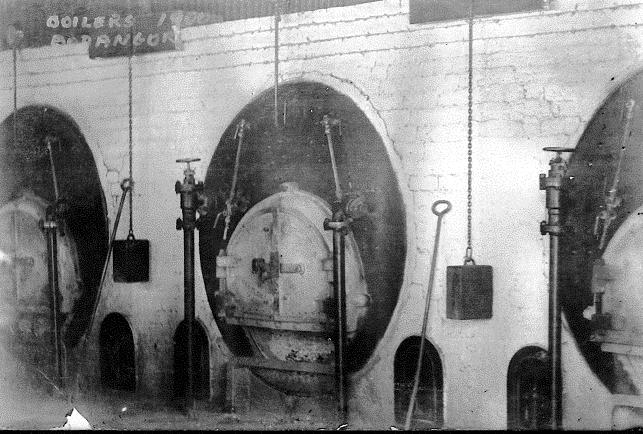
These photos courtesy Barbara Preston show the main shed at the mine, adjacent to the chimney, and steam boilers and engines to operate the mine.
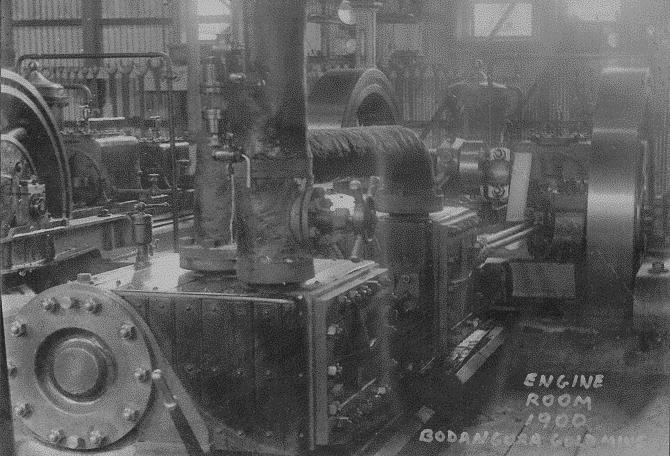
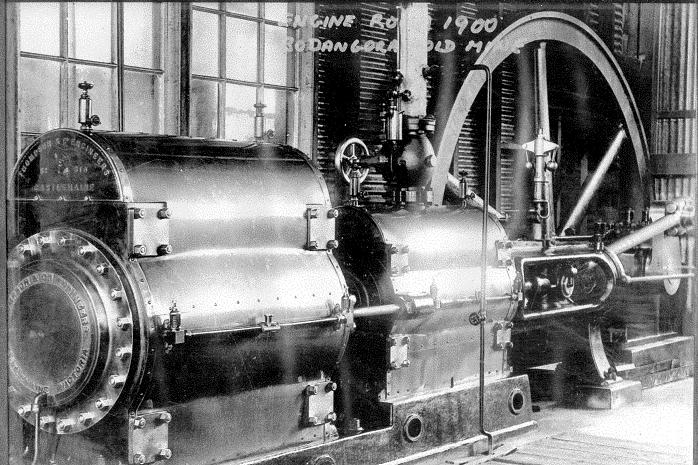
1902
New machinery to the value of £11,280 was erected at the Mitchell's Creek Gold Estate. On an average 180 men were employed.
1903
Some 210 men constantly employed at the Bodangora Mine - value of plant in operation estimated at £24,000.
1904
Mitchell's Creek Gold Mine Ltd. employed some 220 men- value of plant estimated at £55,000.
Mitchell's Creek Mine vested in a Receiver
1905
Mitchell's Creek Mine Vested in a Receiver by the British Court of Chancery. The mine employs on average 228 men.
1906
Mitchell's Creek mine employed on average 224 men.
1907
225 men employed at Bodangora Mine.
Suspension of Operations at Mitchell's Creek & the Commencement of the Treatment of Tailings
1908
The falling off in the returns from the quartz mines (in the Wellington district) is due to the closing down of the Mitchell's Creek Freehold Gold Estate Mine. The suspensions of operations at this mine proved a severe blow to the township of Bodangora; the former population of 900 has dwindled to about 200, and the exodus was continuing at the close of the year. This mine usually employed 200 men, but all underground work has been discontinued, and only some forty men were at work at the end of December, cyaniding the accumulated heaps of tailings.
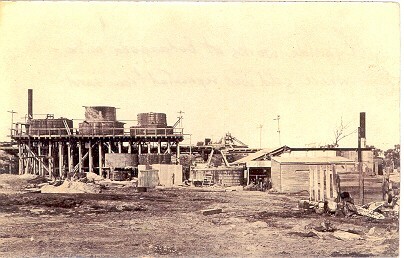
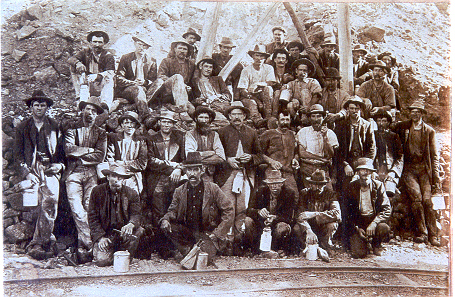
These photos also courtesy of Barbara Preston, show the Bodangora Cyaniding Plant and of photo of workers at Bodangora taken in 1909.
Wellington Gazette
April 16, 1908
NEW CYANIDE PROCESS
'Those interested in cyaniding will shortly have an opportunity of witnessing at the Mitchell's Creek Mine at Bodangora, a new method of working the process which may be described as revolutionary.
The old method was essentially a slow one, the vats having to remain full sometimes as long as three weeks, before the cyanide solution would do its work, and then of course only the finest gold would be saved. In the new process there is a mercurial well at the bottom of the vat. Suspended from the top and nearly reaching to the bottom is a shaft to which are attached a number of blades similar to the blades of a ship's propeller. These are driven at a light rate of speed, working from the outside of the vat to the centre, and the agitation drives a certain amount of oxygen, which is necessary for quick treatment in cyaniding, into the liquid.
The heavy gold drops into the mercurial well and the fine gold is absorbed by the cyanide solution, from which it is recovered in the usual way. The rapidity of treatment by the process will be manifest when it is mentioned that the solution is ready to be run off for precipitation in three hours'.
1909
The Mitchell's Creek Gold Recovery Company purchased the Mitchell's Creek Mine, and work during the year has has been confined to the treatment of the accumulated heaps of tailings and slimes. The quantity of tailings and slimes dealt with is estimated at 33,018 tons, and the bullion recovered amounted to 6,944ozs valued at £15,755. It is estimated that the heaps of tailings and slimes are sufficient to provide work for three years ahead. The shaft on 'Dick's' Reef was being unwatered for the purpose of continuing further prospecting operations.
|
THIS PAGE STILL DEVELOPING



















